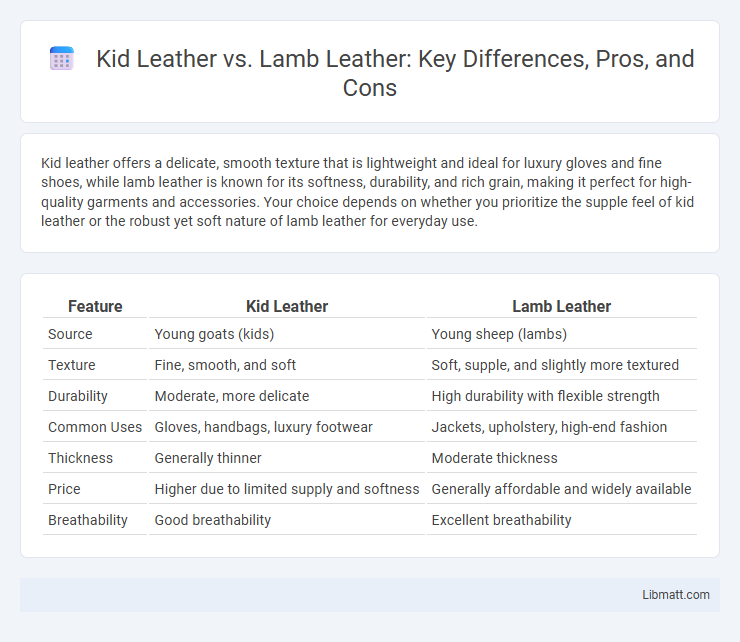Kid leather offers a delicate, smooth texture that is lightweight and ideal for luxury gloves and fine shoes, while lamb leather is known for its softness, durability, and rich grain, making it perfect for high-quality garments and accessories. Your choice depends on whether you prioritize the supple feel of kid leather or the robust yet soft nature of lamb leather for everyday use.
Table of Comparison
| Feature | Kid Leather | Lamb Leather |
|---|---|---|
| Source | Young goats (kids) | Young sheep (lambs) |
| Texture | Fine, smooth, and soft | Soft, supple, and slightly more textured |
| Durability | Moderate, more delicate | High durability with flexible strength |
| Common Uses | Gloves, handbags, luxury footwear | Jackets, upholstery, high-end fashion |
| Thickness | Generally thinner | Moderate thickness |
| Price | Higher due to limited supply and softness | Generally affordable and widely available |
| Breathability | Good breathability | Excellent breathability |
Introduction to Kid Leather and Lamb Leather
Kid leather, derived from young goats typically under six months old, is prized for its exceptional softness, fine grain, and lightweight feel, making it suitable for luxury gloves, shoes, and high-end fashion accessories. Lamb leather comes from lambs usually less than a year old, known for its supple texture, smooth finish, and durability, often used in premium clothing, handbags, and upholstery. Understanding the differences in texture, strength, and uses helps you select the ideal leather type for your specific fashion or design needs.
Origins: Where Kid and Lamb Leather Come From
Kid leather originates from young goats, typically under six months old, prized for its softness and fine grain, while lamb leather comes from young sheep usually less than one year old, known for its smooth texture and lightweight feel. Both types of leather are valued in luxury goods but differ slightly in origin due to the animal source and age at which the hide is harvested. Understanding these origins helps you choose the leather type best suited for your desired use, whether for durability, softness, or aesthetic appeal.
Texture and Softness Comparison
Kid leather offers a smooth and supple texture with a fine grain, making it softer and more pliable than lamb leather, which has a slightly coarser feel due to its thicker fibers. Lamb leather is still soft and luxurious but provides more durability and a slightly firmer touch compared to the delicate nature of kid leather. When choosing leather for garments or accessories, your preference for softness or resilience will guide the best option between these two premium materials.
Durability and Longevity
Kid leather, derived from young goats, offers moderate durability with a soft, supple texture that is prone to showing wear over time. Lamb leather, sourced from young sheep, tends to be more delicate and less durable, often requiring careful maintenance to preserve its appearance. For longevity, kid leather generally outperforms lamb leather due to its tougher grain structure and higher resistance to creasing and abrasion.
Appearance and Aesthetic Differences
Kid leather exhibits a fine, smooth grain with a soft, matte finish that gives it a delicate and luxurious appearance. Lamb leather offers a slightly more pronounced texture with a subtle sheen, providing a supple and elegant aesthetic ideal for high-end fashion. The natural grain patterns in kid leather tend to be more uniform, while lamb leather displays gentle variations that enhance its distinctive character.
Common Uses in Fashion and Accessories
Kid leather, derived from young goats, is prized in fashion for its fine grain, softness, and lightweight feel, making it ideal for luxury gloves, wallets, and high-end footwear. Lamb leather, known for its smooth texture and pliability, is commonly used in tailored jackets, handbags, and premium apparel due to its durability and elegant finish. Both types of leather are favored for accessories and garments where softness and flexibility enhance comfort and style.
Cost and Value Differences
Kid leather generally costs more than lamb leather due to its finer grain and greater softness, which enhances durability and luxury appeal. Lamb leather, while more affordable, offers a smoother texture but may wear faster over time, impacting its long-term value. Your choice depends on balancing initial investment with desired longevity and exclusivity.
Maintenance and Care Requirements
Kid leather requires gentle maintenance using mild, pH-neutral cleaners and regular conditioning to preserve its softness and prevent cracking. Lamb leather, being more delicate and thinner, needs extra care with specialized leather conditioners and avoidance of excessive moisture to maintain its smooth texture. Your leather items will last longer if you store them in breathable bags and keep them away from direct sunlight and heat sources.
Environmental and Ethical Considerations
Kid leather, derived from young goats, tends to have a smaller environmental footprint due to the shorter lifespan of the animals, but ethical concerns arise from the early age at which these animals are slaughtered. Lamb leather also raises ethical questions related to animal welfare but is often considered more sustainable since lambs are typically raised for both meat and leather, promoting resource efficiency. Your choice between kid leather and lamb leather can reflect your values regarding animal treatment and environmental impact within the leather industry.
How to Choose: Kid Leather vs Lamb Leather
Choose kid leather for its exceptional softness, fine grain, and lightweight durability, ideal for high-end gloves and delicate accessories. Opt for lamb leather when seeking a plush, supple texture with a slightly more robust structure, commonly used in fashion garments and luxury handbags. Consider the intended use and desired feel: kid leather suits precision and elegance, while lamb leather offers comfort and resilience.
Kid leather vs lamb leather Infographic

 libmatt.com
libmatt.com